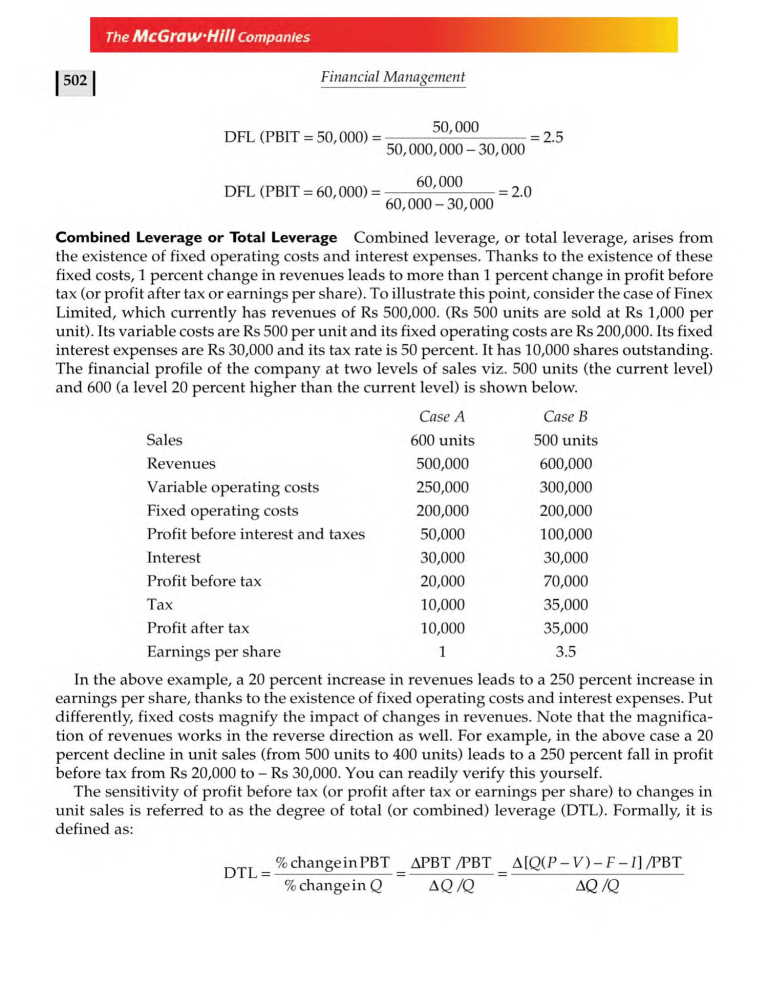
The McGraw-Hill Companies 502 I Financial Management 50/000 DFL (PBIT = 50,000) = = 2.5 50,000,000-30,000 DFL (PBIT = 60,000) = = 2.0 60,000-30,000 Combined Leverage or Total Leverage Combined leverage, or total leverage, arises from the existence of fixed operating costs and interest expenses. Thanks to the existence of these fixed costs, 1 percent change in revenues leads to more than 1 percent change in profit before tax (or profit after tax or earnings per share). To illustrate this point, consider the case of Finex Limited, which currently has revenues of Rs 500,000. (Rs 500 units are sold at Rs 1,000 per unit). Its variable costs are Rs 500 per unit and its fixed operating costs are Rs 200,000. Its fixed interest expenses are Rs 30,000 and its tax rate is 50 percent. It has 10,000 shares outstanding. The financial profile of the company at two levels of sales viz. 500 units (the current level) and 600 (a level 20 percent higher than the current level) is shown below. Case A Case B 600 units 500 units Revenues 500,000 600,000 Variable operating costs 250,000 300,000 Fixed operating costs 200,000 200,000 Profit before interest and taxes 50,000 100,000 Interest 30,000 30,000 Profit before tax 20,000 70,000 Tax 10,000 35,000 Profit after tax 10,000 35,000 1 3.5 Sales Earnings per share In the above example, a 20 percent increase in revenues leads to a 250 percent increase in earnings per share, thanks to the existence of fixed operating costs and interest expenses. Put differently, fixed costs magnify the impact of changes in revenues. Note that the magnification of revenues works in the reverse direction as well. For example, in the above case a 20 percent decline in unit sales (from 500 units to 400 units) leads to a 250 percent fall in profit before tax from Rs 20,000 to - Rs 30,000. You can readily verify this yourself. The sensitivity of profit before tax (or profit after tax or earnings per share) to changes in unit sales is referred to as the degree of total (or combined) leverage (DTL). Formally, it is defined as; T^rrT % change in PBT 1J I L = APBT /PBT = % change in Q A[Q(P -V)-F-I] /PBT = A Q /Q AQ /Q The McGraw-Hill Companies Capital Structure Decision | 503 | _ AQ(P -V) /PBT _ Q(P-V) _ Contribution AQ/Q ~ PBT ~ ^ ^ PBT Note that DTL is simply the product of DOT (degree of operating leverage) and DFL (degree of financial leverage). % change in PBIT DTL = DOL x DFL = % change in sales Contribution PBIT x PBIT PBT Contribution (20.10) PBT To illustrate the calculation of DFL, consider the data for Finex Limited: P = Rs 1,000, P = Rs 500, F = Rs 200,000, and J = Rs 30,000. DTL, which is a function of the level of output (Q) at which it is calculated, may be computed for Q = 500 units and Q = 600 units. DTL (Q = 500) = 500(1,000 - 500) 500(1,000 - 5,000) - 200,000 - 30,000 250,000 = 12.5 20,000 600 (1,000-500) DTL (Q = 600) = 600 (1,000 - 500) - 200,000 - 30,000 300,000 = 4.29 70,000 20.4 = RATIO ANALYSIS Traditionally, firms have looked at certain ratios to assess whether they have a satisfactory capital structure. The commonly used ratios are: interest coverage ratio, cash flow coverage ratio, debt service coverage ratio, and fixed asset coverage ratio. Interest Coverage Ratio The interest coverage ratio (also referred to as the times interest earned ratio) is simply defined as: Profit before interest and taxes Interest on debt To illustrate, suppose the most recent profit before interest and taxes (PBIT) for Vitrex Company were Rs.120 million and the interest burden on all debt obligations were Rs.20 million. The interest coverage ratio, therefore, would be Rs.120 million/Rs.20 million = 6. What does it imply? It means that even if PBIT drops by 83!/3 percent, the earnings of Vitrex Company will cover its interest payment.
